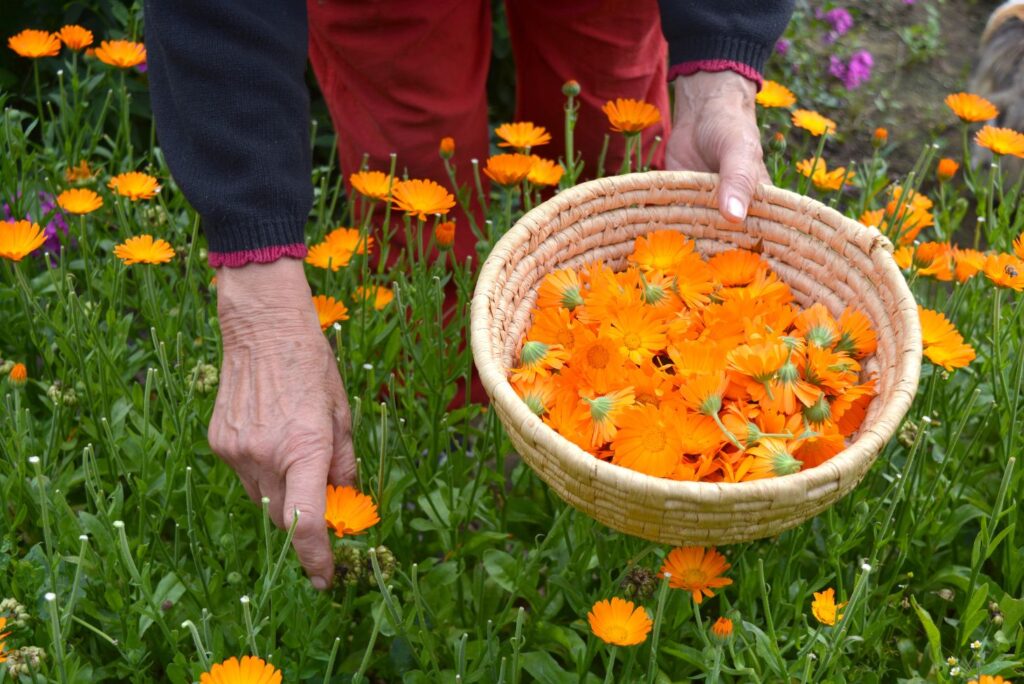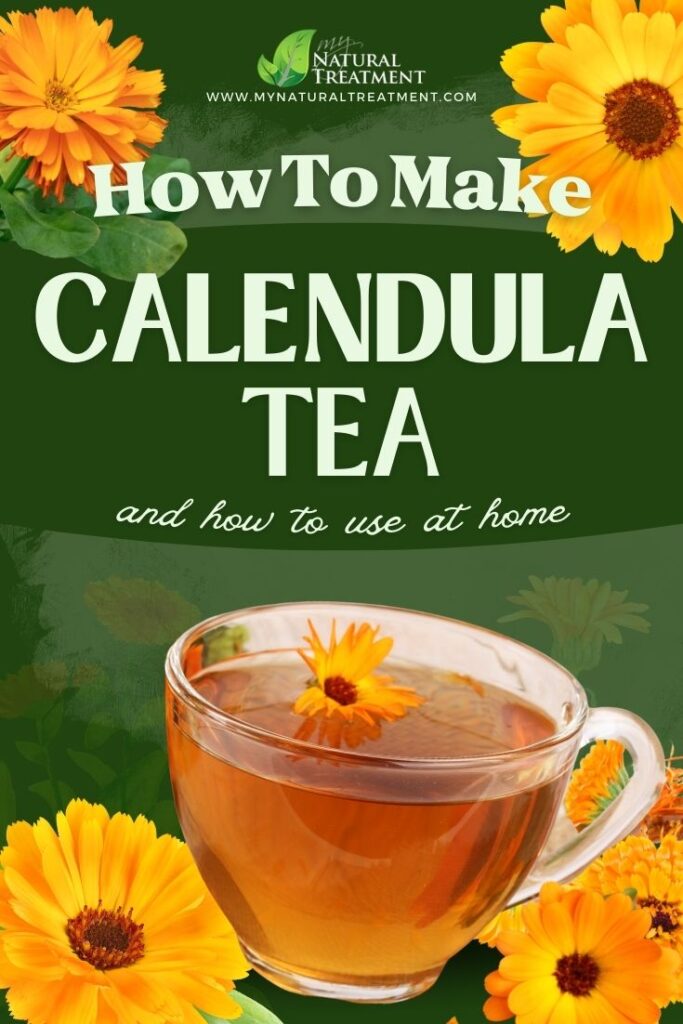Want to learn how to make calendula tea and how to use calendula tea at home? Below is the original calendula tea recipe and how to use it.
Calendula tea is one of the most wonderful ways to use calendulas (Calendula officinalis) as medicine. But before we show you how to make calendula tea and the calendula tea uses, here is how to grow your own marigolds and how to harvest and preserve calendula to make tea. Let’s get to it.

In This Article You Will Find:
How to Grow Calendula
Marigolds (Calendula officinalis), also known as calendulas, can be cultivated in temperate and warm regions, are they originate from India. Calendula is an annual flower, which does not sprout every year from the same root but can be seeded. Ideally, it requires full sun but is also adaptable to other environmental conditions. If you sow it once, it multiplies on its own from year to year, and can even become slightly invasive. Marigolds grow wonderfully between vegetable crops, such as tomatoes, peppers, etc, as they act as natural pest repellents.
How to Harvest Calendula for Tea
Calendulas, also known as marigolds, bloom from May to September, when they can be harvested to make salves, tinctures, teas, and more. For medicinal preparations with marigolds, use only the orange kind of calendula, as the yellow varieties have little to no therapeutic effect. Harvest only the flowers, and pick them by hand, on dry and sunny days. Drying is done in the shade, in well-ventilated places, in a very thin layer. During the drying process, turn the flowers daily, 1-2 times, to facilitate water evaporation. The drying time depends on the season and the yield is 6/1, that is, you get 100 g of dried calendulas from 600 g of fresh flowers.
After drying, keep the calendulas in paper bags, in places without moisture and low light. In order to preserve the active principles unaltered, keep the dried calendulas whole, until the moment of preparing the tea, when you can crush them slightly with your hands.
Dried calendula flowers can be used to make calendula tea, powder, or tincture, while fresh calendulas can be used to make calendula salve, oil, or poultices.
The calendula powder is obtained by grinding the flowers as finely as possible using an electric coffee grinder. If you want to prepare the powder ahead, store it in sealed glass jars, in dark and cold places, and use it over the course of the next 2 weeks maximum. As a rule, the daily dose of calendula powder is one teaspoon administered 4 times a day, on an empty stomach. For abdominal cramps, you can take half a teaspoon of calendula powder before and after meals.

Health Uses of Calendula Tea
Calendula is antiseptic, amazing for digestive ailments and, above all, skin conditions. Several laboratory experiments have shown that the active substances in calendula inhibit the spasms of the digestive tube, restore the digestive epithelia damaged by conditions such as fermentation colitis or putrefactive colitis, and reduce the irritability of the colon. The active principles in calendula, stimulate the smooth muscles of the digestive tube to intensify their movements, thus accelerating the process of digestion, as well as the elimination of fecal matter. Calendula works in gastritis and gastric ulcer by healing the damaged stomach linen without interfering with the gastric juices.
The active principles in calendulas have been found to temper hormonal activity in women. In many cases it can delay menstruation, by up to 3-4 days, reduces bleeding, relieves cramps, and eliminates spasms. Due to its emmenagogue properties, calendula tea favors menstruation in anemic women with irregular menstrual cycles.
Last but not least, calendula extracts have a very strong antitumor action, by inhibiting cancer cells and supporting the immune system to fight against them. These flowers have been used with good results, especially for melanoma, breast, prostate, pancreatic, colorectal, and ovarian cancers, etc. Plus, it has been shown to diminish the negative effects of radiotherapy.

How to Make Calendula Tea – Two Recipes
There are two ways to prepare calendula tea, depending on the health condition you want to relieve. First, we will show you the combined calendula tea, which is a combination of a cold maceration with a decoction. Here is how to make this combined calendula tea at home.
Put 3-4 tablespoons of crushed marigolds to macerate in half a liter of water for 8-10 hours. Strain and set aside. Boil the plant left after filtering in another half liter of water for 5 minutes, then allow it to cool down a bit and strain once again. Finally, combine the two teas. This will make you approximately one liter (4 cups) of combined calendula infusion, which can be used internally (drink 2-3 cups per day) or topically.
The second way to make calendula tea at home is the simple calendula infusion. This is a quicker and simpler version that can be used instead of the combined tea, but it’s best to use each as recommended, as you will see below. To make the simple calendula tea, steep 2 tbsp of dried and crushed marigold flowers in 1 cup of hot water for 30 minutes. Strain, sweeten with raw honey to taste, and drink warm.
11 Amazing Calendula Tea Uses for Health
- Digestive Tract Problems (gastritis, dyspepsia, meteorism, flatulence, bloating, diarrhea, low bile production, and digestive tract spasms) – 3 cups of calendula tea a day (simple infusion). In the case of gastritis or gastric ulcer, used the combined calendula tea instead, one liter (4 cups) a day, over the course of 8 weeks.
- High Cholesterol – administered regularly, calendula tea can decrease lipids (fats) in the bloodstream – 3 cups of calendula tea a day (simple infusion).
- Atonic Colon & Constipation – 2 cups to 4 cups of combined calendula tea a day, over the course of 12 days.
- Anal Problems (hemorrhoids, anal fissures, anal itching, rectitis) – 3 cups of calendula tea a day (simple infusion) and anal washes (sitz baths) with the combined calendula tea.
- Urinary Tract Problems – it has an antispasmodic effect in diseases of the urinary system – 3 cups of calendula tea a day (simple infusion).
- Dysmenorrhoea (painful and possibly irregular menstrual cycle) – 4 teaspoons of calendula powder per day for 3 months. In addition, take vaginal douches with the combined calendula tea. To favor the onset of menstruation in anemic women with an irregular menstrual cycle – any calendula preparation for internal use can be administered, starting approximately 5 days before the first day of menstruation and throughout its duration.
- Allergies (hives, itching, erythema, seasonal eye allergies caused by various allergenic factors such as dust, down, pollen, etc.) – 3 cups of calendula tea a day (simple infusion). Additionally, apply calendula salve or oil topically.
- Dry Cough – has emollient properties and soothes a dry cough that accompanies respiratory tract conditions – 3 cups of calendula tea a day (simple infusion).
- Cancer – 4 tsp of calendula powder per day over the course of 2 months can be of great aid in cancer. Combined calendula tea enemas (200-600 de ml) are recommended for malignant tumors located in the lower abdomen, 12 applications/month.
- Canker Sores & Gum Inflammations – calendula tea has an antiseptic role in oral diseases (canker sores, gingivitis, mycoses, dental abscesses) – 3 cups of calendula tea a day (simple infusion). In addition, rinse 3-4 times a day, for at least five minutes each, with the combined calendula tea. Rinsing reduces gum inflammation, speeds up healing, and prevents gum bleeding and receding gums.
- Respiratory Tract Problems – calendula tea steam inhalations (the simple infusion) are recommended for respiratory system conditions including ENT, or other viral conditions. To increase the effectiveness of these inhalations, add 20 drops of pine, juniper, or eucalyptus essential oil to the calendula tea.
BONUS! Calendula powder is a natural remedy used in fermentation and putrefaction colitis. Make a combination of equal parts of calendula flowers and St. John’s wort powder and take one teaspoon 4-6 times a day, in 21-day courses. Pause for 7 days and resume if needed. It is a simple treatment, but with powerful effects: it restores the intestinal walls damaged by bacterial infection, eliminates spasms and, over time, reduces pain, normalizes intestinal transit, and helps restore the intestinal flora.
Calendula Tea Safety & Precautions
Calendula and calendula extracts used internally are practically non-toxic, as there are no known side effects and contraindications in this sense. Calendulas are edible flowers. However, they should be used with caution, both internally and externally, by those who have allergic sensitivity to plant pollen, to those who take sedative drugs (it seems to amplify the sedative effect), or hypotensive drugs (it also amplifies the hypotensive effects of drugs). Large doses (over 15 grams daily) of calendula extracts administered internally can lead to episodes of hypotension, especially in women and the elderly. Pregnant women should not take more than 5 grams of calendula daily.
A Short History of Calendula
The Latin name calendula comes from the fact that the Romans believed that calendulas bloomed at the beginning of each new month (calendae). The ancient Egyptians valued it, believing that it bought youth and beauty to those using it. The Hindu people decorated their temples with marigolds, while the Persians and Greeks used marigold petals to decorate their dishes for their guests. In the 15th century, the King of England, Henry VIII, intensively used calendula to ward off the plague and leprosy, while during the American Civil War, doctors used calendula leaves to treat the open wounds of soldiers on the battlefield.
More Calendula Recipes:
Calendula Tincture
Calendula Salve
As a result, the marigold acquired an international reputation, being used frequently, even today, thanks to its known cicatrizing, antiseptic, and anti-inflammatory virtues. Nowadays, calendulas are valued especially for their healing virtues. If you’ve enjoyed learning how to make calendula tea, the most important health uses of calendula tea, and how to enjoy this tea at home, depending on your ailment, please share this article so more people can use this information. Stay healthy, naturally!
Share on Pinterest ❤️

